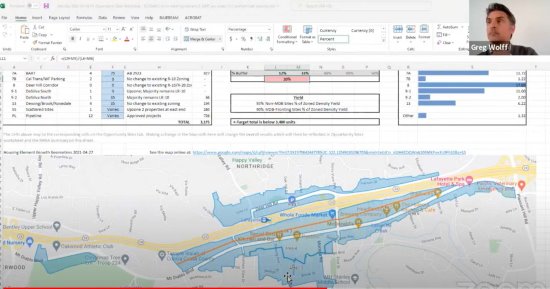
| ||||||
According to the staff report presented by Planning Director Greg Wolff, Senior Planner Renata Robles, and Housing Consultant Diana Elrod, the RHNA process is a requirement for all jurisdictions to plan for future housing needs, ensuring development can occur, should an owner or developer wish to. However, it is not a mandate for jurisdictions to actually construct the units. "State law requires that the Housing Element contain a site-by-site inventory of land suitable for development of all housing types, which are referred to as `opportunity sites.'"
There are 10 areas where environmental impacts have been assessed as part of the Environmental Impact Report and the Commission needed to identify enough area at appropriate densities to accommodate 2,114 housing units, plus a buffer. Senior Planner Renata Robles explained during the initial March 21 Planning Commission meeting that there are limitations on parcel size that are important toward meeting the city's RHNA allocation and that call for specific income categories, and proximity to transit access and to goods and services.
The Planning Commission reviewed five scenarios developed by staff following recommendations made by the General Plan Advisory Committee. The GPAC, chaired by Jim Cervantes and vice chair Matt Pease, has spent the past year and a half working exhaustively with the community to identify opportunity sites to meet the requirements of the 6th Cycle Housing Element, which begins Jan. 1, 2023 and ends in 2031.
Planning Commission Chair Anna Radonich began the April 4 discussion by focusing on the three areas that would have the largest impact on accommodating the city's RHNA allocation - the Deer Hill Corridor, BART, and DeSilva South - and asked whether each commissioner supported including those locations in their recommendation. Radonich, Commissioners Farschad Farzan, Gary Huisingh, Karen Maggio, Gregory Mason and Kristina Sturm all supported including the BART properties, and all agreed with GPAC's recommendation to exclude the area along the Deer Hill Road corridor, due to the fact that it butts up to single family homes and would still require upzoning in other areas to reach the desired housing numbers. Huisingh and Mason said they were on the fence about supporting development on the DeSilva property, while the others did not support it, citing the fact that the property is not in close proximity to transit or goods and services, and would reduce open space. Vice Chair Stephen LaBonge was absent.
During the discussion, Sturm asked Wolff about whether the northern portion of the downtown parcels (Area 1, 3 and 5) that abut Highway 24 could be carved out and zoned at a higher density. Sturm suggested that increasing the density to 45 or 50 dwelling units per acre versus the existing 35 du/ac would offer a way for the city to meet its increased housing requirement without impacting the look of the downtown corridor, or needing to include changes to the Deer Hill Road corridor or the DeSilva properties.
Wolff agreed that this could be an option.
The commissioners also discussed the potential of increasing the BART parking lot area density from 75 du/ac to 80 du/ac, with the potential for mixed-use construction.
Housing Consultant Diana Elrod, who has worked with the State Department of Housing and Community Development on prior Housing Element cycles, expressed concern that the buffer for very-low and low-income housing wasn't high enough. "I don't want the city to have to rezone or go out of compliance in eight years. . The council has always budgeted conservatively, and we're approaching [the Housing Element] in the same vein," said Elrod, who noted that the final decision was up the commissioners and the city.
The commissioners voted unanimously to recommend to staff not to upzone Area 8 north of Deer Hill, not to upzone the DeSilva property South (while keeping the zoning of DeSilva North at 35 du/ac), upzone Areas 1, 3 and 5 that are to the north near Highway 24 to 50 du/ac and upzone BART properties to 80 du/ac with the understanding that staff will be looking at parameters to ensure the buffer is high enough. Staff will return to the Planning Commission on April 18 to review a complete draft of the Housing Element before a final vote to forward the draft HE to the city council for consideration at its May 9 and 23 meetings.
The entire meeting can be viewed on the city of Lafayette's YouTube channel: https://www.youtube.com/watch?v=gOrNwPOqxm0&t=13738s
Reach the reporter at:
